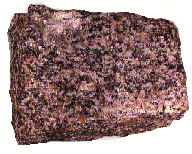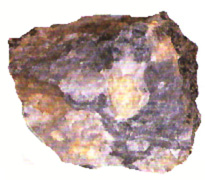What are rocks?
Rocks
are made up of grains of one or more minerals. Rocks form the Earth's
crust and include the surface forms we see everyday.
Sedimentary Rocks cover about three-quarters of the earth’s surface. Sedimentary rocks
form through the erosion, movement, and redeposit of minerals. Over time eroded
rocks and minerals build-up and compress together over millions of years to
form rock. Most sedimentary rocks form in layers and many contain fossils.
Examples:
limestone
sandstone
shale
conglomerate |

Limestone is a Sedimentary rock that contains tiny grains of the mineral calcite. |
Limestone contains tiny grains of the mineral calcite.
Igneous
Rocks form from magma (molten rock) that comes from deep inside the earth. Magma
that cools below the earth’s surface is called intrusive rock. Magma that
cools above the surface such as lava from a volcano is called extrusive rock.
Metal ores and gemstones often form in the veins and fissures of igneous rock.
Quartz forms an important part of most igneous rock.
Examples:
granite (intrusive)
pegmatite (intrusive)
obsidian (extrusive)
basalt (extrusive) |

Granite is an Igneous rock. |
It was formed when magma hardened within the Earth's
crust.
Metamorphic Rocks are rocks that have undergone change. Any type of rock can be metamorphosed—igneous, sedimentary, and other metamorphic rocks. Metamorphism occurs under great heat, pressure and/or permeation of other minerals such as liquid or gas.
Examples:
shale turns to slate
limestone turns to marble
sandstone turns to quartzite
granite turns to gneiss (nice) |

Marble is an Metamorphic rock. |
It was transformed from a Sedimentary
rock by heat and pressure
|